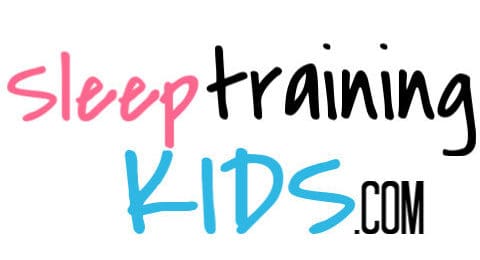When your child’s suddenly waking up in the middle of the night – or waking up more often than usual, it’s hard. And it makes you wonder – is this a sleep regression? And what, exactly, is a sleep regression?
Sleep regressions are a temporary step backward in sleep regularity. They can be due to a life change (like reaching a new developmental milestone), illness, teething, or other factors. While some children can recover from sleep regressions on their own after a few days, most children require parental intervention (via sleep training) to get back to a full night’s sleep.

What is a Sleep Regression?
If you want the short and sweet answer, it’s up above. But for clarity, let’s restate it here.
A sleep regression is a temporary sleep disturbance due to a big change (like reaching a new developmental milestone), illness, or other sleep disrupting factor. Most children require parental intervention (via sleep training or good sleep hygiene and habits) to get back to a regular, full night’s sleep.
But what does that really mean?
Well, it means that kids don’t deal well with change well. And when things do change, it impacts their sleep most of all.
Here are the most common examples of big changes that can trigger a sleep regression:
- milestone development (rolling over, crawling, walking, etc)
- family move
- time change
- new bed or bedroom
- new pet
- sickness
- teething
- anything NEW
In other words, something big and new happened – and your baby is super stressed and anxious about it. Unfortunately, kids can’t tell us that. Well, they’re trying to. They’re just not the greatest at vocalizing that stress yet – because they’re still so young. So instead, they show us that they’re stressed.
So… let’s talk about what a sleep regression looks like.
What does a Sleep Regression Look Like?
When dealing with sleep regression, it can look like one of several things.
- More frequent night wakings
- Longer night wakings
- Earlier morning wakings
- Shorter daytime naps
- More frequent daytime naps
- Fewer daytime naps
- Increased demand to comfort nurses or feed
- Increased demand to be held and physically comforted
- A mix of any or all of the above
In other words, the stress of whatever change happened is causing severe sleep disturbances.
Thankfully, sleep regressions don’t last too long.
How Long are Sleep Regressions?
After four stinky sleepers and tons of sleep-related research, I’ve learned that the experts say that most sleep regressions typically only last a few days or a week. However, they also say it’s not uncommon for a sleep regression to last as long as a month.
Why such a range in time? Well, it depends on several factors:
- Do you let the child try to adjust on their own?
- Will you be helping them adjust by sleep training?
- Are there other physical factors (like sickness) causing this particular regression?
Families who are dealing with additional issues, like health concerns, may see longer sleep regressions as they consult with their doctors and others for help.
In other words, the families who see shorter sleep regressions are the ones who either have super resilient babies who adjust quickly OR families who use regular, consistent, and reliable sleep training methods to nip those sleep disturbances in the behind.
Next, let’s talk about how many sleep regressions you can expect to see.
How Many Sleep Regressions Are There?
Well, it depends. There are commonly-seen sleep regressions at well-defined milestones:
- 3-5 months of age
- 8 months of age
- 11 (10-12) months old
- 15-18 months old
- 2 years old
We’ll talk about the commonly-reached milestones that trigger these regressions later on.
All this being said, your baby may not experience every sleep regression. For more information on when sleep regressions happen, make sure you read my article on sleep regression timing.
Will My Child Experience Every Sleep Regression?
Your child may or may not experience every sleep regression. It’s going to depend on their personality, your family situation, and so many other factors.
Your child could have sleep regressions above and beyond these. Or they may not experience it exactly on time.
There’s no real way to know beforehand which ones your child will have or skip. However, being aware of the common sleep regressions can help you plan for them so that you can help shorten them in length and intensity.
Could My Child Have More Sleep Regressions?
Yes, they could. But it doesn’t mean that they will.
For example, my oldest boy didn’t walk until about 14 months old. So he had a fun little regression at 14 months of age – followed by another one at about 17 months when the very-normal separation anxiety stage of child development kicked in.
We also traveled to another state and experienced a time change with our oldest boy. Guess what happened? Yup! He had an unexpected sleep regression.
Then, when he turned two? Guess what happened? Not a single peep – he was a solid sleeper and skipped that commonly dreaded 2-year regression.
What Triggers a Sleep Regression?
Change causes sleep regression. Mostly these changes are bigger things – like a move, a new sleeping environment, or reaching a big milestone.
What milestones are being reached at these particular ages?
- At 3-5 months old, your child will have learned to hold their head up and how to roll over. Rolling over is what usually triggers sleep regression.
- At about 8 months of age, your child will have learned to crawl and maybe even cruise along with the furniture. Either one of those is enough to trigger a regression.
- At about 10-12 months of age, most babies have mastered cruising and/or walking. This will trigger another regression.
- At 15-18 months of age, they hit a phase of psychological development where they get hit with a strong case of separation anxiety. This may trigger a sleep regression.
- At 2 years old, your child may outgrow naps – and this can trigger another backslide in the sleeping department.
That being said, it can also be triggered by smaller changes, too. Teething has triggered small sleep regressions in my kids, as has to lose a favorite stuffed animal or blanket.
Thankfully, though, regressions caused by lost blankets and animals in our family have usually been quickly fixed by finding those lost stuffies – or replacing them with another that’s been deemed sufficient by our child.
Will my Child Adapt On Their Own?
Some children could adapt on their own. However, in my research and experience, the number of children who do adapt on their own isn’t very large. That, or there’s a very vocal number of parents whose children don’t adapt.
Either way, if your child does adapt on their own, that’s amazing. Congratulations.
There does, however, seem to be a trend for those kids who self-adapt to sleep regressions: their parents seem to all have great sleep training skills. Some of them are natural and some are developed with practice.
Either way, kids who self-adapt have parents who can help them self-adapt to sleep regressions.
For example, our youngest child seemed to adapt to sleep issues better than her older siblings did. Then, we realized that she wasn’t better adjusted to dealing with them: we were better at recognizing them and helping her adapt.
So whether your kids would self-adapt well or not, learning how to sleep train your children is an invaluable skill that will always help.

How do I Manage a Sleep Regression?
The key to managing any sleep regression is knowing how to sleep train your child.
Now, that doesn’t mean that you start over with sleep training every time there’s a step backward.
Rather, it means that you use the skills, techniques, and tricks you’ve learned from sleep training to help your child get back on track faster.
For more information on sleep training, be sure to check out my comprehensive article on how to know if sleep training is necessary.
Sleep regressions don’t have to be a pain in the rear. But it helps if you have a sleep training plan – and a reference book with a planner to help you track progress. Here is our recommendation on the best sleep training books (and planners) to have in your home library.
